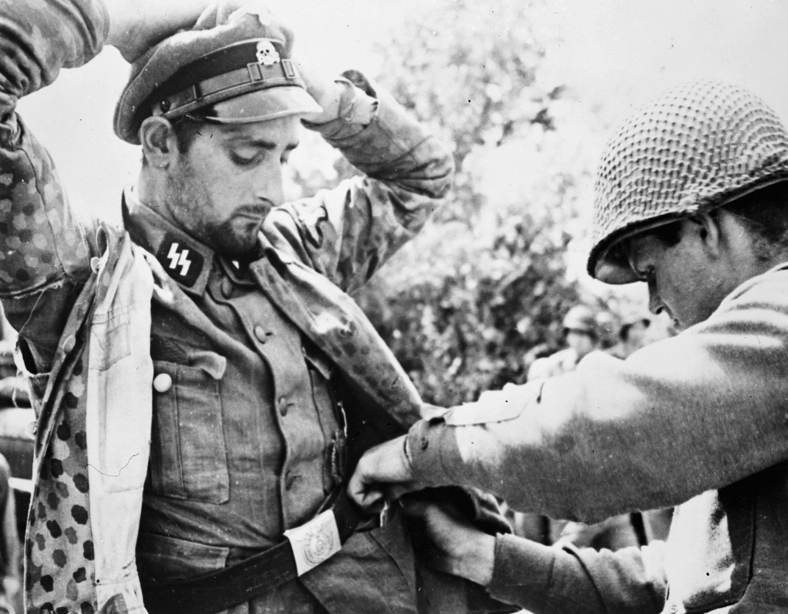RARE! WWII Normandy France D-Day Captured German Infantry & Armored Division Map (with U.S. Soldier's Captured Information)


































RARE! WWII Normandy France D-Day Captured German Infantry & Armored Division Map (with U.S. Soldier's Captured Information)
Comes with a hand-signed C.O.A.
This extremely rare and museum-grade WWII D-Day artifact titled “NORDWEST-FRANKREICH - DEUTSCHE HEERESKARTE” (NORTHWEST FRANCE - GERMAN ARMY MAP) is a German map that was captured shortly following the Allied D-Day landings on Utah, Omaha, Gold, Sword, and Juno Beaches in Normandy.
This captured German map of Normandy is what is known as a “theater-printed” map. Theater printed maps were done on the front line (in theater), in a hurry, and using whatever paper or supplies were available. This means that these are extremely low print counts and were made for very unique situations. Because this map shows all FIVE of the Allied beaches of the D-Day invasion of Normandy it is believed that this map was printed just prior to the Allied landings in Normandy and was used by German Infantry or Armored Divisions or it was printed just after the landings to reinforce and support the German divisions to push the Allies back towards the beaches.
What makes this D-Day captured German map even more rare and interesting this that this Normandy theater printed map is printed was printed on the backside of a German invasion of Britain map (the German D-Day invasion that never happened).
The Germans were well aware that an invasion was imminent, and they had spent years preparing for it. They had constructed a series of fortifications along the coast of France known as the Atlantic Wall, which included concrete bunkers, anti-tank obstacles, and minefields. They had also stationed troops and artillery units along the coast to repel any invading forces.
When the invasion began, the Germans were initially caught off guard. The Allies had chosen to land on the beaches of Normandy, which the Germans had deemed less likely due to the rough terrain and difficult access. As a result, the German defenses were weaker in this area, and the Allies were able to establish a beachhead.
However, the Germans quickly rallied, and over the next few days, fierce fighting took place on the beaches and in the surrounding towns. The Germans utilized their well-constructed defenses and were able to repel several Allied attacks. The Germans also had the advantage of being familiar with the terrain, as they had spent years studying the coastline and the surrounding areas.
The fighting in Normandy was intense, and both sides suffered heavy casualties. The Germans had the advantage of being able to call on reinforcements from other areas, but this also meant that they had to defend a large front line. The Allies, on the other hand, had the advantage of being able to bring in more troops and supplies, but they had to overcome the German defenses and advance through unfamiliar terrain.
The Germans also utilized their air superiority to great effect, launching devastating bombing raids on the Allied troops and supply lines. This made it difficult for the Allies to advance and resupply their troops, as they were constantly under attack from the air.
Despite these challenges, the Allies continued to advance, and by the end of June, they had captured the city of Caen. This was a significant victory, as Caen was a major transportation hub and a key point in the German defenses. However, the Germans continued to put up a fierce resistance, and the fighting in Normandy continued throughout July.
The Germans utilized several tactics to slow the Allied advance, including the use of snipers, booby traps, and ambushes. They also launched several counterattacks, which were initially successful but ultimately proved to be ineffective. The Allied troops had superior firepower and were able to repel the German attacks, although they suffered heavy casualties in the process.
By the end of July, the Allies had secured most of Normandy, and the German defenses were crumbling. However, the fighting had taken a heavy toll on both sides, and the Germans had lost many troops and much of their equipment. The Allied victory in Normandy paved the way for their eventual liberation of France and the defeat of Nazi Germany.
In conclusion, the Germans during the D-Day invasion and subsequent fight in Normandy, France, faced significant challenges and fought fiercely to defend their territory. They utilized their well-constructed defenses, air superiority, and knowledge of the terrain to repel several Allied attacks. However, the Allies were ultimately able to overcome these obstacles and secure a foothold in Nazi-occupied Europe. The fighting in Normandy was intense and took a heavy toll on both sides, but it marked a significant turning point in World War II and paved the way for the eventual Allied victory.